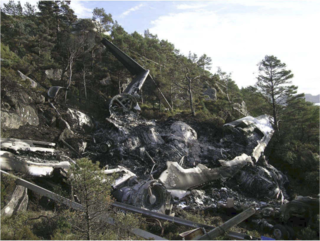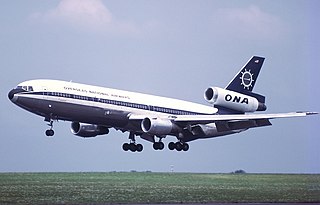
The McDonnell Douglas DC-10 is an American trijet wide-body aircraft manufactured by McDonnell Douglas. The DC-10 was intended to succeed the DC-8 for long-range flights. It first flew on August 29, 1970; it was introduced on August 5, 1971, by American Airlines.
Capitol Air was a United States supplemental air carrier and, after 1978, a scheduled passenger air carrier based which was operational from 1946 to its bankruptcy filing on November 23, 1984. From 1964, supplemental air carriers were simply charter carriers. Until 1964, however, supplemental air carriers were a scheduled/charter hybrid. Supplemental air carriers were also known as irregular air carriers or nonscheduled carriers. The airline was founded as Capitol Airways in 1946, and renamed Capitol International Airways in 1967. In 1981, the airline changed its name to Capitol Air and was operating scheduled domestic and international passenger flights that year.

Air France Flight 358 was a regularly scheduled international flight from Charles de Gaulle Airport in Paris, France, to Toronto Pearson International Airport in Ontario, Canada. On the afternoon of 2 August 2005, while landing at Pearson airport, the Airbus A340-313E operating the route overran the runway and crashed into nearby Etobicoke Creek, approximately 300 m (980 ft) beyond the end of the runway. All 309 passengers and crew on board the Airbus survived, but twelve people sustained serious injuries. The accident highlighted the vital role played by highly trained flight attendants during an emergency.

Air Canada Flight 189 was an Air Canada flight from Ottawa to Vancouver via Toronto and Winnipeg. On June 26, 1978, the McDonnell Douglas DC-9 operating the flight crashed on takeoff in Toronto, killing two passengers.

Qantas 1 was a Qantas passenger flight between Sydney and London. On 23 September 1999, the aircraft operating as Flight 1 had departed from Sydney that day, and was involved in a runway overrun accident at Don Mueang International Airport in Bangkok as it was landing for a stopover.

Atlantic Airways Flight 670 was a crash following a runway overrun of a British Aerospace 146-200A at 07:32 on 10 October 2006 at Stord Airport, Sørstokken, Norway. The aircraft's spoilers failed to deploy, causing inefficient braking. The Atlantic Airways aircraft fell down the steep cliff at the end of the runway at slow speed and burst into flames, killing four of sixteen people on board.

FedEx Express Flight 14 was a scheduled cargo flight from Singapore to Newark, New Jersey, via Malaysia, Taiwan, and Alaska. On July 31, 1997, the aircraft flying this route crashed during landing on its final segment at Newark International Airport (EWR), inverting and catching fire, injuring all five people on board.

Nigeria Airways Flight 2120 was a chartered passenger flight from Jeddah, Saudi Arabia, to Sokoto, Nigeria, on 11 July 1991, which caught fire shortly after takeoff from King Abdulaziz International Airport and crashed while attempting to return for an emergency landing, killing all 247 passengers and 14 crew members on board. The investigation traced the fire to underinflated tires which overheated and burst during takeoff, and subsequently discovered that a project manager had prevented those tires from being replaced because the aircraft was behind schedule. The aircraft was a Douglas DC-8 operated by Nationair Canada for Nigeria Airways. Flight 2120 is the deadliest accident involving a DC-8 and the deadliest aviation disaster involving a Canadian airline.
Air France has been in operation since 1933. Its aircraft have been involved in a number of major accidents and incidents. The deadliest accident of the airline occurred on June 1, 2009, when Air France Flight 447, an Airbus A330-203, flying from Rio de Janeiro to Paris crashed into the Atlantic Ocean with 228 fatalities. A selected list of the most noteworthy of these events is given below.

Continental Airlines Flight 603 was a scheduled McDonnell Douglas DC-10 flight between Los Angeles International Airport and Honolulu International Airport. On March 1, 1978, it crashed during an aborted takeoff, resulting in the deaths of four passengers.

Reeve Aleutian Airways Flight 8 was an American domestic flight from Cold Bay, Alaska, to Seattle, Washington, on June 8, 1983. Shortly after takeoff, the Lockheed L-188 Electra of Reeve Aleutian Airways was travelling over the Pacific Ocean when one of the propellers broke away from its engine and struck the fuselage, damaging the flight controls. The pilots were able to make an emergency landing at Anchorage International Airport; none of the 15 passengers and crew on board were injured in the accident.

Alaska Airlines Flight 779 was a contract cargo flight operated on 21 July 1961 by an Alaska Airlines Douglas DC-6A that crashed short of the runway at Shemya Air Force Base with the loss of all six crew members on board.

Propair Flight 420 (PRO420) was a domestic charter flight from Montreal, Quebec to Peterborough, Ontario. The flight was carried out by Propair, a charter airline based in Rouyn-Noranda, Quebec, using a Fairchild Metroliner SA226. On 18 June 1998, the aircraft suffered an in-flight fire shortly after take-off from Dorval and the crew elected to conduct an emergency landing at Montréal–Mirabel International Airport. The intense heat of the fire caused a structural failure in the left wing during the landing and the aircraft crashed, resulting in the deaths of all 11 passengers and crew on board.

Pan Am Flight 799 was an international cargo flight from Los Angeles International Airport to Cam Ranh Airport in South Vietnam that crashed on December 26, 1968, near Anchorage, Alaska. The aircraft involved was a Boeing 707-321C aircraft operated by Pan American World Airways. All three crew members died in the crash.

American International Airways Flight 808 was a cargo flight operated by American International Airways that crashed on August 18, 1993 while attempting to land at Leeward Point Field at the Guantánamo Bay Naval Base in Cuba. All three crew members on board survived with serious injuries.

On 23 December 1983, Korean Air Lines Flight 084 (KAL084), a McDonnell Douglas DC-10-30CF performing a cargo flight, collided during its takeoff roll with SouthCentral Air Flight 59 (SCA59), a Piper PA-31-350, on runway 06L/24R at Anchorage International Airport, as a result of the KAL084 flight crew becoming disoriented while taxiing in dense fog and attempting to take off on the wrong runway. Both aircraft were destroyed, but no fatalities resulted.

Overseas National Airways (ONA) Flight 032 was a non-scheduled positioning flight operated by Overseas National Airways with a McDonnell Douglas DC-10-30CF. On November 12, 1975, the flight crew initiated a rejected takeoff after accelerating through a large flock of gulls at John F. Kennedy International Airport, resulting in a runway excursion. Of the 139 aircraft occupants, all survived, while the aircraft was destroyed by an intense post-crash fire. The National Transportation Safety Board concluded that the probable cause of the accident was bird ingestion into the right-hand engine, causing an uncontained engine failure that ruptured several landing gear tires and disabled the engine's hydraulic system, in turn partially disabling the spoilers and the landing gear brakes. Contributing to the accident was the resultant failure of the affected engine's thrust reverser and the wet runway. The accident aircraft is claimed to be the largest commercial airliner ever destroyed due to a bird strike.

Japan Air Lines Cargo Flight 46E was a scheduled cargo flight on 31 March 1993, operated by Evergreen International Airlines, on behalf of Japan Air Lines, from Anchorage International Airport, in Anchorage, Alaska, to O'Hare International Airport, in Chicago. After departure, while climbing through 2,000 feet, the pylon for engine two detached, causing the whole engine to fall off the wing. The pilots managed to land the 747 back at Anchorage without further incident.

















